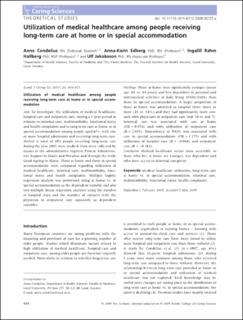| dc.contributor.author | Condelius, A. | |
| dc.contributor.author | Edberg, A. | |
| dc.contributor.author | Hallberg, I. R. | |
| dc.contributor.author | Jakobsson, U. | |
| dc.date.accessioned | 2021-01-11T10:16:56Z | |
| dc.date.available | 2021-01-11T10:16:56Z | |
| dc.date.issued | 2010 | |
| dc.identifier.citation | Condelius, A., Edberg, A., Hallberg, I. R., & Jakobsson, U. (2010). Utilization of medical healthcare among people receiving long-term care at home or in special accommodation. Scandinavian Journal of Caring Sciences, 24 (2), 404-413. | en_US |
| dc.identifier.uri | https://hdl.handle.net/11250/2722323 | |
| dc.description.abstract | Aim: To investigate the utilization of medical healthcare, hospital care and outpatient care, during a 1‐year period in relation to informal care, multimorbidity, functional status and health complaints and to long‐term care at home or in special accommodation among people aged 65+, with one or more hospital admissions and receiving long‐term care.
Method: A total of 694 people receiving long‐term care during the year 2001 were studied. Data were collected by means of the administrative registers Patient Administrative Support in Skåne and PrivaStat and through the study Good Ageing in Skåne. Those at home and those in special accommodation were compared regarding utilization of medical healthcare, informal care, multimorbidity, functional status and health complaints. Multiple logistic regression analysis was performed using at home vs. in special accommodation as the dependent variable and also two multiple linear regression analyses using the number of hospital stays and the number of contacts with the physician in outpatient care separately as dependent variables.
Findings: Those at home were significantly younger (mean age: 81 vs. 84 years) and less dependent in personal and instrumental activities of daily living (PADL/IADL) than those in special accommodation. A larger proportion of those at home was admitted to hospital three times or more (21 vs. 14%) and they had significantly more contacts with physicians in outpatient care (md: 10 vs. md: 7). Informal care was associated with care at home (OR = 0.074) and with utilization of outpatient care (B = 2.045). Dependency in PADL was associated with care in special accommodation (OR = 1.375) and with utilization of hospital care (B = −0.060) and outpatient care (B = −0.581).
Conclusion: Medical healthcare seems more accessible to those who live at home are younger, less dependent and who have access to informal caregivers. | en_US |
| dc.publisher | Scandinavian Journal of Caring Sciences | en_US |
| dc.subject | medical healthcare utilization | en_US |
| dc.subject | long‐term care at home vs. in special accommodation | en_US |
| dc.subject | informal care | en_US |
| dc.subject | multimorbidity | en_US |
| dc.subject | functional status | en_US |
| dc.subject | health complaints | en_US |
| dc.title | Utilization of medical healthcare among people receiving long‐term care at home or in special accommodation | en_US |
| dc.type | Journal article | en_US |
| dc.source.pagenumber | 404-413 | en_US |
| dc.source.volume | 24 | en_US |
| dc.source.journal | Scandinavian Journal of Caring Sciences | en_US |
| dc.source.issue | 2 | en_US |
| dc.identifier.doi | https://doi.org/10.1111/j.1471-6712.2009.00725.x | |
| dc.description.localcode | måsjekkes | |
